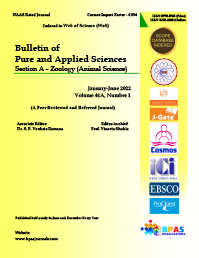Environmental Factors Affecting the Distribution of Selected Free Living Isopods in the Southern Coast of Kerala, India
DOI:
https://doi.org/10.48165/bpas.2023.42A.2.3Keywords:
Isopod, Intertidal, Abiotic factorsAbstract
Intertidal isopods are a group of successfully surviving organisms in the littoral region of the sea. The continuous exposure to human activities and other botic and abiotic stresses can influence their distribution and diversity along the seashore. Air and water temperature, salinity, pH, and presence of nutrients such as silicate, nitrate and phosphate are studied for their influence on some of the selected intertidal isopods found in three different beaches of the southern Kerala. Monthly data was collected for the water samples and four different isopod species found in the intertidal region and the significance of their interaction was calculated with the help of SPSS, using two-way ANOVA. The statistics shows a vivid relationship between these abiotic factors and isopods under study.
Downloads
References
Alenius. B., Munguia. P. (2012). Effects of pH variability on the intertidal isopod, Paradella dianae, Marine and Freshwater Behaviour and Physiology, Vol. 45(4), 245-259.
https://doi.org/10.1080/10236244.2012.727 235
Al-Kandari. M.A., Khalaji-Pirbalouty. V., Abdulkhaliq. V., Chen. W. (2022). Diversity and distribution of the Isopoda (Crustacea, Peracarida) of Kuwait, with an updated checklist, ZooKeys 1080, 107–133.
Austin. A.T., Yahdjian. L., Stark. J.M. (2004).Water pulses and biogeochemical cycles in arid and semiarid ecosystems, Oecologia, Vol. 141, No. 2, 221–235. doi: 10.1007/s00442-004-1519-1
Bakalem. A, Pezy. J.P. and Dauvin. J. C. (2021). Inventory and Geographical Affinities of Algerian Cumacea, Isopoda, Mysida, Lophogastrida and Tanaidacea (Crustacea Peracarida), Diversity. Vol.13, No.6, 221.
Bendschneider. K., Robinson. R. J. (1952). A New Spectrophotometric Method for the Determination of Nitrite in Sea Water, Journal of Marine Research, Vol. 11, 87-96.
Brown. J. H. (1984). On the Relationship between Abundance and Distribution of Species, The American Naturalist, 124(2), 255–279.
Brown. J.H. (1984). On the relationship between distribution and abundance of species, The American Naturalist, 124(2), 255−279.
Cable. J.M., Ogle. K., Williams. D.G. (2008). Soil Texture Drives Responses of Soil Respiration to Precipitation Pulses in the Sonoran Desert: Implications for Climate Change, Ecosystems, 11(6), 961–979. doi:10.1007/s10021-008-9172-x
Csonka. D., Halasy. K., Szabó P., Mrak. P., Štrus. J., Hornung. E. (2013). Eco morphological studies on pleopodal lungs and cuticle in Armadillidium species (Crustacea, Isopoda, Oniscidea), Arthropod Structure and Development, 42(3), 229–235.
Dailey. T.M., Claussen. D.L., Ladd. G.B., Buckner. S.T. (2009). The effects of temperature, desiccation, and body mass on the locomotion of the terrestrial isopod, Porcellio laevis, Comparative biochemistry and physiology. Part A, Molecular & integrative physiology, 152(2), 162-166. doi: 10.1016/j.cbpa.2009.02.005.
Dehnel. P. A. (1960). Effect of Temperature and Salinity on the Oxygen Consumption of Two Intertidal Crabs, Biological Bulletin, 118(2), 215–249.
https://doi.org/10.2307/1538998
Gavel. I., Byrne. M., Thomson. M. (2022). Effects of raised temperature on viviparous reproduction in the marine isopod Cirolana harfordi, Journal of Experimental Marine Biology and Ecology, Vol. 546. https://doi.org/10.1016/j.jembe.2021.15164
Hurtado. L.A., Mateos. M., Santamaria. C.A. (2010). Phylogeography of supralittoral rocky intertidal Ligia isopods in the pacific region from central California to central Mexico, PLoS One, 5(2).
https://doi.org/10.1371/journal.pone.00116 33
Ingólfsson. A, (1977). Distribution and Habitat Preferences of Some Intertidal Amphipods in Iceland, Acta naturalia Islandica, Museum of Natural History, Iceland.
Ingólfsson. A, Agnarsson. I. (2003). Amphipods and isopods in the rocky intertidal: dispersal and movements during
igh tide, Marine Biology, 143(5), 859–866. DOI:10.1007/s00227-003-1132-6
Jha. D. K., Sharma. G.D., Mishra. R.R. (1992). Soil microbial population numbers and enzyme activities in relation to altitude and forest degradation, Soil Biology and Biochemistry, 2498, 761-767.
Kavita Joshi. (2010). Spatial and Temporal Variations in Population Dynamics Of Few Key Rocky Intertidal Macrofauna At Tourism Influenced Intertidal Shoreline; Thesis; Registration No: 3720, Dated 31-07-
, Department Of Biosciences, Saurashtra University, India.
Koroleff. F., Grasshoff. K., Ehrhardt. M., Kremling. K. (1983). Methods of seawater analysis, 2nd edn. Verlag Chemie, Weinheim, New York.
Lei. F., Poulin. R. (2011). Effects of salinity on multiplication and transmission of an intertidal trematode parasite, Marine Biology, 158, 995–1003. https://doi.org/10.1007/s00227-011-1625-7
Little. C., KitChing. J.A. (1996). The Biology of Rocky Shores, Oxford University Press, England.
McQueen. D. J., Carnio J. S. (1974). A laboratory study of the effects of some climatic factors on the demography of the terrestrial isopod Porcellio spinicornis Say, Canadian Journal of Zoology, 52(5), 599-611. https://doi.org/10.1139/z74-078
Mottaghi, A., & Reimer, J. (2019). Comparing the diversity of interstitial crustaceans at natural and artificial/degraded beaches in Okinawa. Regional Studies in Marine Science.
Peterson. M.E., Daniel. R.M., Danson. M.J., Eisenthal. R. (2007). The dependence of enzyme activity on temperature: determination and validation of parameters, Biochemical Journal, 402(2), 331-7. doi: 10.1042/BJ20061143
Raffaelli. D., Hawkins. S., (1996). Intertidal Ecology, Kluver Academic Publishers, Netherlands.
Sagarin. R. D., Gaines. S. D. (2002a). The ‘abundance centre’ distribution: to what
extent is it a biogeographical rule?, Ecology Letters, 5(1), 137−147. https://doi.org/10.1046/j.1461-
2002.00297.x
Sagarin. R. D., Gaines. S. D. (2002b). Geographical Abundance Distributions of Coastal Invertebrates: Using One Dimensional Ranges to Test Biogeographic Hypotheses, Journal of Biogeography, 29(8), 985–997.
Song. J., Fan. H., Zhao. Y., Jia. Y., Du. X., Wang. B. (2008).Effect of salinity on germination, seedling emergence, seedling growth and ion accumulation of a euhalophyte Suaeda salsa in an intertidal zone and on saline inland, Aquatic Botany, 88(4), 331-337.
https://doi.org/10.1016/j.aquabot.2007.11.0 04
Strickland. J.D.H., Parsons. T.R. (1968). Practical Handbook of Seawater Analysis, Bulletin of Fisheries Research Board of Canada, 167, 1–311.
Tattersall. G.J., Tyson. T.M., Lenchyshyn. J.R., Carlone. R.L. (2012). Temperature preference during forelimb regeneration in the red-spotted newt Notophthalmus viridescens, Journal of Experimental Zoology Part A: Ecological and Integrative Physiology, 317(4), 248-58. doi: 10.1002/jez.1719
Warburg. M.R., Linsenmair. K.E., Berkowitz. K. (1984). The effect of climate on the distribution and abundance of isopods, Symposia of the Zoological Society of London, 53, 339–367.
Wilson. W. J. (1970). Osmoregulatory Capabilities in Isopods: Ligia occidentalis and Ligia pallasii, Biological Bulletin, 138(1), 96– 108.
Ziegler. A., Hagedorn. M., Ahearn. G.A., Carefoot. T.H. (2007). Calcium translocations during the moulting cycle of the semiterrestrial isopod Ligia hawaiiensis
(Oniscidea, Crustacea), Journal of Comparative Physiology B, 177(1), 99-108. 33. Zohary. T., Gasith. A. (2014).The Littoral Zone, Aquatic Ecology, 6, 517-532.
